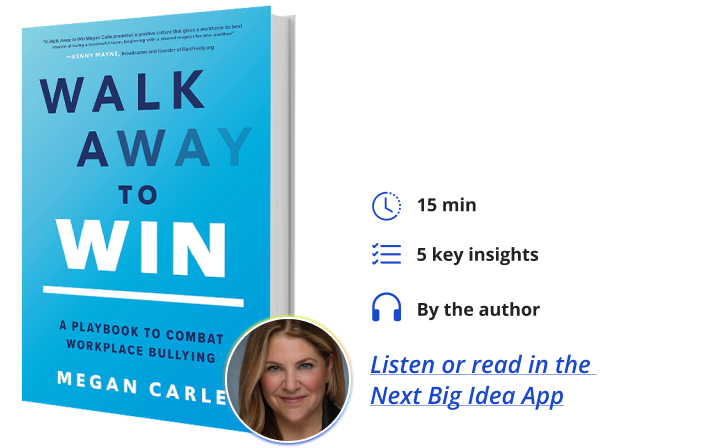Megan Carle spent 30 years rising through the ranks at Nike, leaving the company during her time as Vice President of Basketball for North America. While at Nike, her business involved superstar athletes such as LeBron James, Kobe Bryant, and Kevin Durant. Now she is self-employed as a consultant committed to the mission of resetting toxic workplace cultures.
Below, Megan shares 5 key insights from her new book, Walk Away to Win: A Playbook to Combat Workplace Bullying. Listen to the audio version—read by Megan herself—in the Next Big Idea App.

1. Recognize it.
According to research conducted in 2021 by the Workplace Bullying Institute (WBI), approximately 80 million U.S. workers have been affected by workplace bullying. Eighty million is a big number: it’s two Californias, or one Germany, and it’s also half the United States workforce. Despite the prevalence of this experience, most targets of this behavior feel alone, guilty, and ashamed, which is why workplace bullying is known as the undiscussable. After experiencing workplace bullying myself—and realizing how much it affected my physical and mental health, and my work performance—I made the difficult decision to walk away from the company I had worked at for nearly 30 years.
Putting a name to workplace bullying behaviors helps everyone. Language helps targets of bullying because they finally have words to describe this terrible thing. Language helps colleagues because now they know what is happening to the co-workers they care about. And language helps leaders because they can’t fix a problem they can’t describe.
“Putting a name to workplace bullying behaviors helps everyone.”
One woman relayed to me one of many soul-crushing encounters with a boss who’d gone from ally to enemy: “When I recounted the just-ended meeting to my counselor, and how it made me feel, I remember she said, ‘You know that’s bullying, right?’ I was shocked. I didn’t know that. Bullying was what we talked to our elementary school children about. It happens when kids don’t understand how their words hurt others and cover up their own insecurities by attacking those they perceive as weak and vulnerable. That doesn’t happen in the workplace where we are all professional adults. We talked further about it. What I remember from that conversation was how it felt to hear her name what was happening to me and recognize it as a professional opinion. That it wasn’t just me not being able to handle a difficult, diminishing boss. I didn’t feel better, but I felt validated, maybe a little less crazy, and a little bit relieved. I gained a tiny bit of control in a time when I felt I had zero agency over my own experience, by giving this a name. Bullying.” Unless we name it, we can’t discuss it.
2. Understand it.
Understanding the cultural context in which workplace bullying thrives is so important for both targets and leaders. Workplace bullying doesn’t happen in a vacuum. It’s a symptom of larger problems within a company’s organizational health. It’s why management consultant Peter Drucker famously said, “Culture eats strategy for breakfast.” In other words, what is accomplished at work plays second fiddle to how it is accomplished. When leaders lose sight of their most important resource by treating people as commodities, things go downhill.
How can you tell if your workplace is one in which hostility, toxicity, and ultimately workplace bullying will thrive? Here are a few markers to watch out for:
- Is your company focused on the bottom line instead of being mission-oriented?
- Are top-down turf wars rewarded instead of collaboration and trust? As someone shared with me: “I still remember the meeting in which the then president looked out at a room full of people and said, ‘C’mon…I don’t have all the answers…let’s figure it out.’ I knew at that moment I was in the right place.”
- When unhealthy markers stack up—myopic behavior, autocratic structure, compliance-above-all—employees will feel the negative effects of an unhealthy workplace culture and workplace bullying will become the norm.
3. Identify your response options.
Identifying how you’ll respond to workplace bullying is critical. It’s like playing a sport and knowing you have different moves available based on what is happening on the pitch, the court, or the track.
When I experienced workplace bullying, I had one move: compliance. I approached my bullies like I was in that romantic comedy 50 First Dates. In the film, Drew Barrymore has no short-term memory, so Adam Sandler must woo her every single day. Like Drew’s character, I behaved as if I had no memory of the bullying behavior thrown at me by a well-established workplace bully. I expected something different every time I interacted with them. I anticipated the best because that’s who I am, and when the worst would come at me, I wasn’t ready. I wish I had had my list of moves to make.
Here are four responses from which to choose: ignore, resist, comply, enlist. To ignore means refusing to engage, and instead detach and walk away. To resist means to hold your ground, set boundaries, and counter their attempts at bullying. To comply means to do as you’re told and hope the situation goes away. And finally, to enlist is to draw on your workplace allies for support. Identifying your best move will help you feel like you have options.
4. Define your win.
If you are not supported by your company when you’re a target of bullying, you have the power to decide your next decision. Some people will stay and aggressively look for another role in-house, away from their bully. Some will enlist HR or Employee Relations for help. Some people take legal action. Some will walk away and find a new career—and a new lease on life.
It’s important for individuals to understand that they can do these things. It’s also important to understand that your bully probably won’t change. As one person shared with me: “I finally decided to go to HR for help and the first question I was asked was, ‘What did you do to prompt this behavior?’ I was floored. I had already become a shell of my former self, and I knew at that moment that I would have to leave. I knew that the place I had devoted so much to was not going to support me. I had to save myself before the company took even more away from me.”
“It’s not worth keeping one bully on staff when it means losing talented people in droves.”
If companies don’t help employees who need it, they will lose those employees and many more. It’s not worth keeping one bully on staff when it means losing talented people in droves. When we let go of the idea that we must withstand workplace bullying, we free ourselves of the stifling and unsuitable labels we might assign ourselves: failure, quitter, loser. We are not failures, quitters, or losers. Instead, we define our own win.
5. You are not alone.
Targets of bullies often feel alone, or that the bullying is somehow their fault. When a former colleague asked me to coffee, I was surprised and touched by the direction she took the conversation. She said, “I could see something was happening to you at work. I could tell. You were always this big, charismatic person who was so full of energy and light. And I saw you get small. I knew something was wrong. I just wish I had reached out. Even just to let you know I see you. I’m here for you. I regret that I didn’t do that.”
If you are experiencing workplace bullying or know someone who is, please don’t suffer in silence. Seek help. You can move past workplace bullying, find a new path, and recover from the trauma. You didn’t allow workplace bullying to happen to you, and you didn’t deserve it or somehow cause it. You can move on and redefine what winning and thriving look like for you. You are not alone.
And to the business leaders, managers, and CEOs out there: workplace bullying is not a behavior that anyone should tolerate or condone. You must make a concerted effort to acknowledge when it’s happening and make every effort to create a healthy workplace organization and culture for all employees.
To listen to the audio version read by author Megan Carle, download the Next Big Idea App today:































